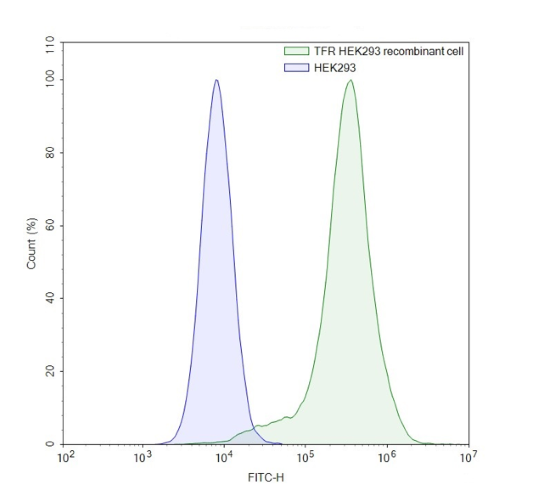Anti-Transferrin Receptor Antibody, FITC-Labeled
This anti-Transferrin Receptor (TfR) antibody is a purified recombinant antibody, which is labeled with Fluorescein isothiocyanate (FITC). This antibody has been tested by flow cytometry for binding to human TfR on the surface of Transferrin Receptor Protein-1 (TFRC) HEK293 Recombinant Cell Line (BPS Bioscience #78308).
≥90%
Aqueous buffer solution.
8 mM Phosphate, pH 7.4, 110 mM NaCl, 2.2 mM KCl, 0.09% Sodium Azide, 0.2% BSA, and up to 20% glycerol. May contain a protein stabilizer.
Fluorescein isothiocyanate (FITC) is a derivative of fluorescein and has excitation and emission spectrum peak wavelengths of approximately 495 nm and 519 nm (green).
Transferrin Receptor Protein-1 (also known as TfR1 or CD71) is a cell surface receptor that binds holo-transferrin (Tf) with high affinity, forming an iron-Tf-TfR complex that is endocytosed. TfR1 is crucial for cellular health, as iron acts as a co-factor for many enzymes involved in metabolism and ROS (reactive oxygen species) formation. Deregulated iron levels, and consequently ROS formation, correlate with multiple disease states including Parkinson’s Disease, Amyotrophic Lateral Sclerosis (ALS), Huntington’s Disease, Multiple Sclerosis (MS), and tumorigenesis. TfR1 is upregulated on the surface of tumor cells and endothelial cells in the brain, presenting TfR1 as a promising candidate for targeted therapy in leukemia, lymphoma and neurological diseases. Studies of TfR1 function and expression patterns will broaden our knowledge and support possible applications in therapy.


